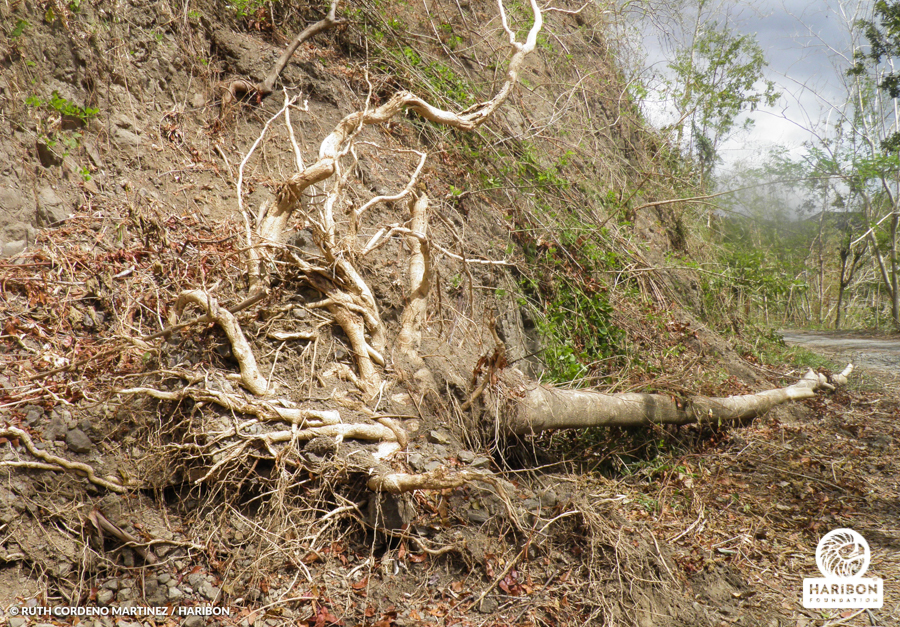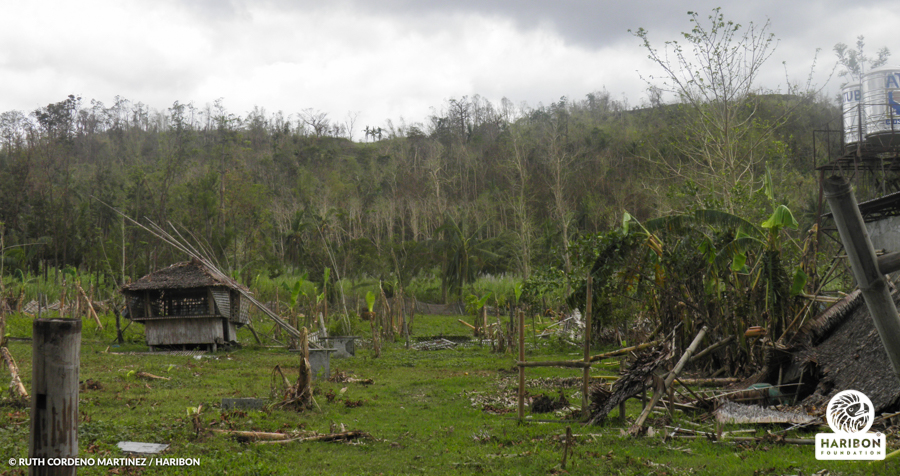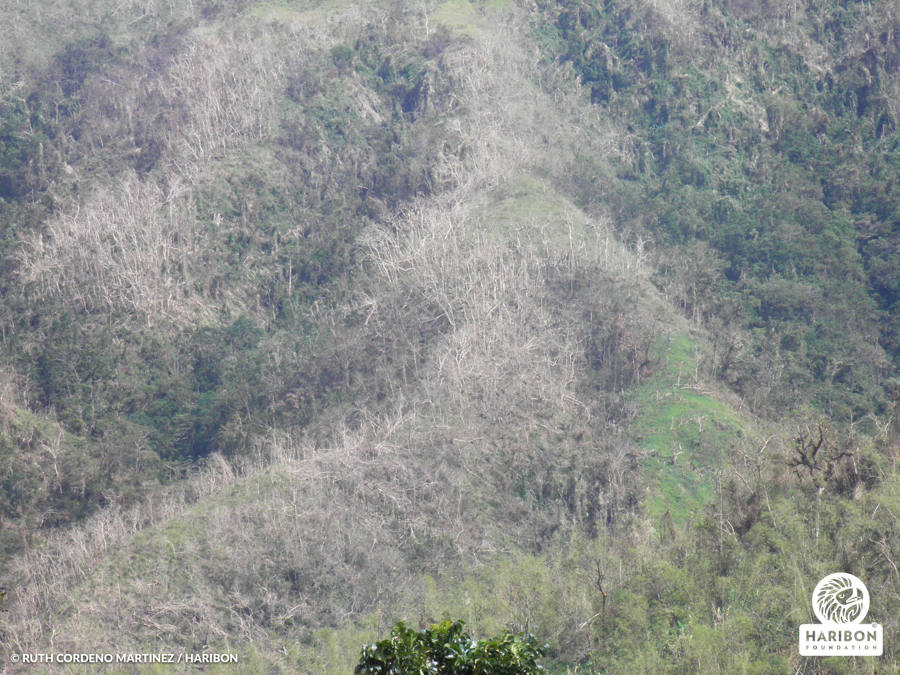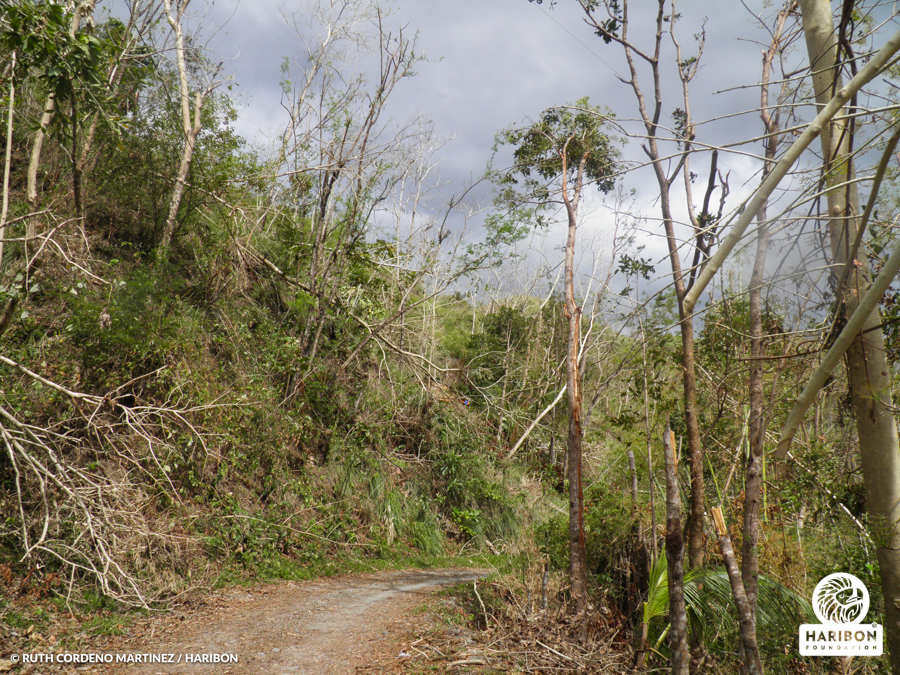Super typhoon Yolanda, which lashed parts of Visayas and Southern Luzon, in the Philippines weeks ago, is one of the world’s strongest storms ever in recorded history with an average strength of 195 mph (315kph), left utter devastation along its path leaving thousands homeless, frantic and lifeless. PAGASA Weather Center raised Public Storm Warning Signal Number 4 over several areas, a rare occurrence when cyclones struck the Philippines. Yolanda is also Category 5 in Saffir-Simpsons Hurricane Scale, capable of causing “catastrophic damage.”
Haribon sites in Central Panay Mountain Ranges were also hard hit by Yolanda. As reported by the Antique Provincial Disaster Risk Reduction and Management Council (PDRRMC), San Jose, Antique has a total of 13 deaths. A total of 91 persons were injured and 16 missing while 12,136 families, and 54,279 persons lost their homes, properties and livelihood.
Seven of the nine hardest-hit municipalities in the province are all Haribon sites, Bugasong, Laua-an, Barbaza, Tibao, Culasi, Sebaste and Pandan; the other municipalities are Libertad and Caluya. According to the PDRRMC, a total of 337 barangays in these towns were also affected.
Damage to infrastructures in the region reached P 150 million while agriculture damages reached P 110 million on rice, corn and cassava, high value crops, livestock and fisheries.
Wrath of Nature
Some sectors of society are saying that the strong typhoons, heavy rains, and the flooding is Nature’s way of getting back at our excesses.
But what is happening now is part of a natural cycle that we have disturbed and we have not respected. We have built large dams instead of allowing rivers to flow freely. We have allowed the entry of logging concessions in the forests, and of course, mining. We have arbitrarily built concrete structures instead of allowing, open spaces such as marshlands and wetlands to thrive. Mangroves and other coastal forests, which act as buffer zones during natural hazards, were cut indiscriminately to give way to land reclamations, fishponds and other coastal development and pollution.
Dr. Gerry Bagtasa of the University of the Philippines Institute of Environmental Science and Meteorology said there was nothing to stop Yolanda into intensifying. “It never hit a mountainous area to break its wind speed. Everything fell into place,” said Bagtasa.
According to the author of “Preserving the Mountains”, Zenaida G. Delica, “the Philippines, lying along a typhoon belt, is visited by an average of 19-20 cyclones a year. Most typhoons emanate from the Pacific Ocean which lies at the eastern board of the Philippines. A natural mitigation measure is the mountain range located along the eastern coast of the country. Other mountains which dot the country have aided as natural barriers to the strong winds which often reach the velocity of more than 250 kms per hour.
Damage to infrastructures in the region reached P150 million.
“Most mountains situated near the major population centers have been denuded by logging and uncontrolled subdivision development programs initiated more than fifty years ago. Recently, leveling average-sized mountains and strip mining have combined to destroy the mountains themselves.”
It has always been our call to protect and conserve our forests from these threats. Time and again, Haribon Foundation has reminded Filipinos about the role of forests in mitigating the impacts of climate change and the risks of disasters, especially floods and landslides. Forests are the first line of defense against flooding and landslide. When forests are intact, there is enough holding capacity and the flow of water is controlled, not directly hitting the soil thus reducing the impact of surface run-off. This then minimizes the occurrence of flash floods and landslides.
This case actually happened in some portions of Central Panay Mountains Important Biodiversity Area (IBA) particularly in the remaining forest areas of the municipalities of Sebaste in Antique province and Ibajay in the province of Aklan. There is a clear line of resiliency between the old growth forest and reforestation areas established in circa 70s. From the highway, it can be observed and noted that old growth forests remained blue-green in hue, as if undaunted by the onslaught of super typhoon Yolanda. Old reforestation sites, most likely planted with exotic species such as mahogany, gmelina, among others, have turned the forest landscape into brown. It looks like winter/fall where the trees totally shed its leaves. Gmelina trees, which found it hard to withstand the catastrophe, were fallen and uprooted.
In Tibiao, rows of exotic trees with no leaves after typhoon Yolanda. Patches of intact and green trees along the gully remain intact. These green trees are all native species.
Forest vegetation also plays an important role in water holding and water absorption. Decrease in forest vegetation puts many communities at risk of different hydro-meteorological hazards because of our country’s very close location to the Pacific Ocean. Any increase in sea surface temperature as a result of climate change could affect the weather condition.
In Barbaza town in the province of Antique, residents affected by the typhoon experienced extreme changes in temperature because of less forest cover and exposure to sea surface temperature due to their proximity to Sulu sea. If the forest cover is small, there will be small amount of rainfall that will be directly intercepted by trees and other vegetation to be stored in the aquifers. Surface run-off occurs mostly in deforested/ cleared areas, resulting to erosion and siltation of the rivers, creeks, and other tributaries.
According to Haribon’s head of research department Dr. Margarita Lavides, “it is expected that when a significant amount of areas are devoid of vegetation, the temperature will rise in the local area because of the lack of transpiration (release of water from plant surfaces) to air. It’s connected to the hydrometeorological processes and its relationship with vegetation. The situation may be more complex than this as we continue to unearth impacts of climate change, i.e. increased temperature, in ecosystems and human beings. Climate change and its impacts involve biophysical processes, but the problem is most of the time, the government and the public consider only the physical side of it such as the wind, rainfall, temperature, geology – forgetting that the biological side, e.g. vegetation, is just an important element.”
Seven of the nine hardest-hit municipalities in the province are all Haribon sites, Bugasong, Laua-an, Barbaza, Tibao, Culasi, Sebaste and Pandan.
Forest cover plays an important role in the hydrological cycle. The smaller the forest cover, the greater surface run-off will occur. If there is enough forest cover, great amounts of rainwater will be intercepted and stored in the aquifers.
The government of the Philippines should immediately revisit and rethink its forest conservation strategy based on the impact of Yolanda particularly on forest restoration. The objective of reforestation is to rehabilitate degraded and denuded forestlands; however, the use of exotic species resulted to further damage because it does little in protecting us from typhoons, with its shallow roots and even destroys the integrity of the natural forests and biodiversity by making conditions unattractive for local wildlife to flourish. Exotic trees species are more vulnerable compared to indigenous species, to like super typhoon Yolanda.
The use of rainforestation technology, by bringing back the natural state and integrity of the Philippine forests, is the perfect conservation strategy to combat climate change and protect vulnerable communities because of its resiliency to disasters and other catastrophes. Natural forests provide protection services to immediate communities, during floods, landslide and soil erosion, among its numerous benefits.
In Lauan, those left standing and still with leaves, after being hit by Yolanda, were Tipolo and Kamansi trees, both native species.
Climate Change and Human Factor
Just as disasters are not entirely attributed to natural causes, we must also recognize that the extreme weather events that we continue to experience are also driven by human factors. The Intergovernmental Panel on Climate Change 2007 Fourth Assessment Report (AR4) has already stated that among other observed climatic changes, human influences has “more likely than not increased risk of heat waves, area affected by drought since the 1970s and frequency of heavy precipitation events,” (IPCC, 2007).
It is important that the human-influenced and human-induced causes e.g. deforestation, overexploitation etc. of both climate change and disasters, be seriously addressed by all sectors of society, but most especially our government. It is also imperative that climate change mitigation and adaptation measures and disaster risk reduction work which includes biodiversity conservation, at all levels, i.e. ecosystem, species, genetic, be given utmost priority by our government.
Most of the trees planted in Lauan were Gmelina and Mahogany.
We believe and support the call for the correct formulation, appropriate legislation at both local and national levels, and proper enforcement of comprehensive land use plans (CLUP) for every city and municipality in the country. Beyond the call and the move to restore mangrove areas, forest restoration using indigenous forest trees species should also be included in local development plans such as Forest Land-use Plans (FLUP), the Disaster Risk Reduction Management Plans (DRRMP), among others, of communities to mitigate the effects of climate change. All partner stakeholders should be aware and have the capacity to translate all these conservation and development strategies into local actions that may halt any untoward incidents, which are detrimental to human lives. We cannot be held hostage by the impacts of disasters.
But we, Filipinos, also have the spirit of bayanihan, a long-held tradition of mutual cooperation among members of a community. We have in our culture the elements that we can harness to prevent and minimize the impacts of disasters. If we make use of this tradition of bayanihan to extend to protecting and planting more forests, then we have a bigger chance of keeping ourselves safe from the impacts of disasters.
On the island of Panay, Haribon works with several community sites in all four provinces of the island: Iloilo, Aklan, Antique, and Capiz. The Forest and Climate Protection Project (ForCLIM) includes various community projects in the following towns: Janiuay, Calinog, and Lambunao in Iloilo, Ibajay and Madalag in Aklan, Barbaza, Lauan and Culasi in Antique, and Tapaz in Capiz.
After the disaster, Haribon staff collected relief goods at our main office in Quezon City for our community sites on the island of Panay. Canned food, dried noodles, and bottles of water were collected. Donors came in and dropped everything from cash to clothes. Funds for the organization Christmas party were also routed to purchase supplies and relief goods for our sites on Panay.
The Central Panay Mountain Range of the island have been a focus of a multi-lateral campaign to protect its forests and “The Big Five” species via the establishment of a Critical Habitat (CH). There Haribon works along side the Department of Environment and Natural Resources (DENR), Local Government Units (LGU’s), and upland communities to protect forests, local biodiversity, and improve the livelihoods of adjacent communities.
Sources:
Santos, Reynaldo Jr., “Yolanda and the world’s strongest storms”, Rappler.com, 10 November, 2013.
Chossudovsky, Michel, “Global warming, Typhoon Haiyan and the Philippines”, rt.com, 14 November, 2013.
Gearin, Mary, “Climate change makes super typhoons worse, says UN meteorological agency”, abc.net.au, 14 November, 2013.
Francisco, Mikael Angelo, “Why was Typhoon Yolanda so strong? Scientists chime in”, gmanetwork.com, 13 November, 2013.
Mclavor, Spencer, Moller, Spalding, “Storm Surge Reduction by Mangroves”, www.wetlands.org
Ramos, Osorio, “REDD+ in the Philippines: Legal status and conservation of mangrove forests in the Philippines”, Internal Journal of Rural Law and Policy, http://epress.lib.uts.edu.au/journals/index.php/ijrlp/article/view/3359
Delica, Zenaida G., “Preserving the Mountains”, http://www.adpc.net/infores/adpc-documents/zen-mountains.pdf
Panela, Shaira, “Super Typhoon Yolanda: The recipe of a perfect tropical cyclone”, Sun Star Manila, 18 November, 2013
http://www.fao.org/forestry/tsunami/27285@69434/en/




